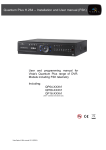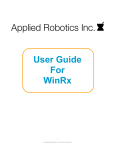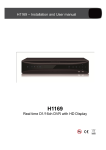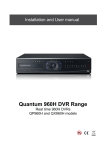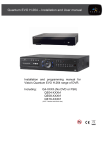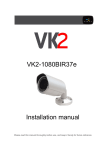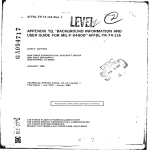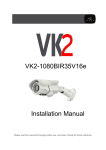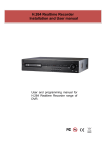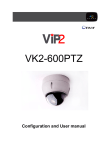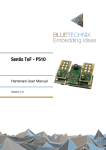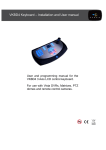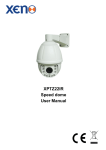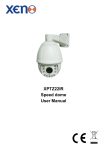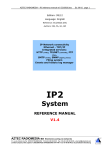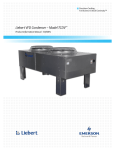Download User manual - Network Webcams
Transcript
Installation and User manual QNVR04P/08P HD Network Video Recorder with PoE QVNR04P/08P installation and user manual 2 QNVR_PoE 4 and 8 channel manual V1.0 QVNR04P/08P installation and user manual Before You Begin Read these instructions before installing or operating this product. Note: This installation should be made by a qualified service person and should conform to local codes. This manual provides installation and operation information. To use this document, you must have the following minimum qualifications: A basic knowledge of CCTV systems and components A basic knowledge of electrical wiring and low-voltage electrical connections Intended use Only use this product for its designated purpose; refer to the product specification and user documentation. Customer Support For assistance in installing, operating, maintaining and troubleshooting this product refer to this document and any other documentation provided. If you still have questions, please contact Norbain Technical Support and Sales: Norbain SD Ltd, 210 Wharfedale Road, IQ Winnersh, Wokingham, Berkshire RG41 5TP, England. UK +44 (0) 118 912 5000 Note: You should be at the equipment and ready with details before calling Technical Support. Conventions Used in this Manual Boldface or button icons highlight command entries. The following WARNING, CAUTION and Note statements identify potential hazards that can occur if the equipment is not handled properly: * WARNING: Improper use of this equipment can cause severe bodily injury or equipment damage. ** Caution: Improper use of this equipment can cause equipment damage. Note: Notes contain important information about a product or procedure. This apparatus is manufactured to comply with the radio interference. A Declaration of Conformity in accordance with the following EU standards has been made. The manufacturer declares that the product supplied with this document is compliant the p rovisions of the EMC Directive 2004/108/EC, the CE Marking Directive 93/68 EEC and all associated amendments. All lead-free products offered by the company comply with the requirements of the European law on the Restriction of Hazardous Substances (RoHS) directive: 2011/65/EU, which means our manufacture processes and products are strictly “lead-free” and without the hazardous substances cited in the directive. The crossed-out wheeled bin mark symbolizes that within the European Union the product must be collected separately at the product end-of-life. This applies to your product and any peripherals marked with this symbol. Do not dispose of these products as unsorted municipal waste. * This symbol indicates electrical warnings and cautions. 3 QNVR_PoE 4 and 8 channel manual V1.0 QVNR04P/08P installation and user manual ** This symbol indicates general warnings and cautions. NORBAIN SD LTD reserves the right to make changes to the product and specification of the product from time to time without prior notice. WARNINGS AND CAUTIONS: To reduce the risk of fire or electric shock, do not insert any metallic objects through the ventilation grills or other openings on the equipment. CAUTION CAUTION RISK OF ELECTRIC SHOCK DO NOT OPEN WARNING: TO REDUCE THE RISK OF ELECTRIC SHOCK, DO NOT REMOVE COVER (OR BACK). NO USER-SERVICABLE PARTS INSIDE. REFER SERVICING TO QUALIFIED SERVICE PERSONNEL. 4 QNVR_PoE 4 and 8 channel manual V1.0 QVNR04P/08P installation and user manual Contents BEFORE YOU BEGIN .......................................................................................................... 3 INTENDED USE.................................................................................................................... 3 CUSTOMER SUPPORT ........................................................................................................ 3 WARNINGS AND CAUTIONS: ............................................................................................. 4 CAUTION ........................................................................................................................................................ 4 CAUTION ........................................................................................................................................................ 4 OVERVIEW ........................................................................................................................... 7 1. CONTENTS OF PACKING .................................................................................................... 7 2. FEATURES ....................................................................................................................... 8 INSTALLATION .................................................................................................................... 9 1. FRONT PANEL CONTROLS ................................................................................................. 9 2. REAR PANEL CONNECTORS .............................................................................................10 3. REMOTE CONTROL ..........................................................................................................12 4. CONNECTION GUIDE........................................................................................................13 5. TURNING ON THE NVR ....................................................................................................15 OPERATION ........................................................................................................................16 1. NAVIGATION ....................................................................................................................16 1-1. Mouse Control ........................................................................................................................................ 16 1-2. Menu Navigation .................................................................................................................................... 16 2. MONITORING ...................................................................................................................17 2-1. OSD Description ..................................................................................................................................... 17 2-2. Select Channel ....................................................................................................................................... 17 2-3. Digital Zoom ........................................................................................................................................... 18 3. PLAYBACK ......................................................................................................................19 3-1. OSD Description ..................................................................................................................................... 19 3-2. Playback Control .................................................................................................................................... 19 3-3. Playback Search .................................................................................................................................... 20 4. PTZ CONTROL ................................................................................................................21 4-1. PTZ Control by mouse............................................................................................................................ 21 4-2. PTZ Control by remote keyboard ........................................................................................................... 23 4-3. PTZ Control by remote controller ........................................................................................................... 23 4-4. PTZ Control by Client software ............................................................................................................... 23 SETUP MENU ......................................................................................................................24 1. DISPLAY .........................................................................................................................24 1-1. OSD Setting ........................................................................................................................................... 24 1-2. Live Setting............................................................................................................................................. 26 1-3. Camera Covert ....................................................................................................................................... 27 1-4. Camera Name ........................................................................................................................................ 27 2. IP CAMERA .....................................................................................................................28 2-1. Basic....................................................................................................................................................... 28 2.2 Accessing the cameras Web pages ......................................................................................................... 30 2-2. Normal (Time Lapse) .............................................................................................................................. 31 2-3. Alarm ...................................................................................................................................................... 32 2-4. Motion..................................................................................................................................................... 33 2-5. Schedule ................................................................................................................................................ 34 3. SYSTEM..........................................................................................................................36 3-1. Basic....................................................................................................................................................... 36 3-2. Disk ........................................................................................................................................................ 38 3-3. Account................................................................................................................................................... 39 3-5. PTZ Setup .............................................................................................................................................. 41 5 QNVR_PoE 4 and 8 channel manual V1.0 QVNR04P/08P installation and user manual 3-6. More ....................................................................................................................................................... 41 4. NETWORK .......................................................................................................................42 4-1. Basic....................................................................................................................................................... 42 4-2. NTP ........................................................................................................................................................ 43 5. EVENT ............................................................................................................................44 5-1. E-Mail Registration ................................................................................................................................. 44 5-2. E-mail Out .............................................................................................................................................. 45 5-4. Alarm Out ............................................................................................................................................... 46 SEARCH MENU...................................................................................................................47 1. SEARCHING RECORDED DATA ..........................................................................................47 1-1. Date/Time Search................................................................................................................................... 47 1-2. Event Search .......................................................................................................................................... 48 1-3. Calendar Search .................................................................................................................................... 48 1-4. Bookmark Search ................................................................................................................................... 49 2. ARCHIVING EVIDENCE TO DVD/CD OR USB .....................................................................52 3. LOG ..............................................................................................................................54 CLIENT VIEWER SOFTWARE ............................................................................................55 1. LIVE MONITORING ...........................................................................................................58 2. REMOTE SEARCH ............................................................................................................61 2-1. Search .................................................................................................................................................... 61 2-2. Archive.................................................................................................................................................... 63 2-3. Remote Log ............................................................................................................................................ 65 2-4. Information ............................................................................................................................................. 66 3. REMOTE SETUP (MENU SETTINGS - SAME AS DVR) ...........................................................67 3-1. Display.................................................................................................................................................... 67 3-3. System ................................................................................................................................................... 69 3-4. Event ...................................................................................................................................................... 71 4. LOCAL SEARCH (VIEWING DOWNLOADED FOOTAGE) ...........................................................73 4-1. Search .................................................................................................................................................... 73 4-2. Log ......................................................................................................................................................... 75 4-3. Info ......................................................................................................................................................... 75 5. LOCAL SETUP .................................................................................................................76 5-1. Global ..................................................................................................................................................... 76 5-2. Opacity ................................................................................................................................................... 76 5-3. Audio Buffer ............................................................................................................................................ 77 5-4. Camera Name ........................................................................................................................................ 77 6. TELEMETRY CONTROL (PAN/TILT/ZOOM/FOCUS) ...............................................................78 6-1. Pan / Tilt / Zoom / Focus ........................................................................................................................ 78 6-2. Preset / Learn ......................................................................................................................................... 79 7. SCREEN POSITION SAVE/LOAD ........................................................................................80 7-1. Screen Position Save ............................................................................................................................. 80 7-2. Screen Position Load ............................................................................................................................. 80 8. FIRMWARE UPGRADE ......................................................................................................81 APPENDIX 1 ........................................................................................................................82 DYNAMIC IP (SUPPORTING DDNS SERVER) .........................................................................82 APPENDIX 2 ........................................................................................................................84 SETUP FOR DVR PORT & WEB SERVER PORT USING IP SHARING ROUTER ...............................84 APPENDIX 3 ........................................................................................................................85 SPECIFICATION ...................................................................................................................85 6 QNVR_PoE 4 and 8 channel manual V1.0 QVNR04P/08P installation and user manual Overview 1. Contents of Packing AC Adaptor Mouse Battery (AAA x2) Remote Controller Installation CD 7 QNVR_PoE 4 and 8 channel manual V1.0 QVNR04P/08P installation and user manual 2. Features ● Convenience - User-friendly GUI (Graphical User Interface) - Easy-to-use menu structure - Easy-to-use recorded data search (Time, Date, Motion, and Alarm) - Easy-to control via IR remote control and USB 2.0 mouse. ● Stability - Auto restart after power interruption - DB structure offers data stabilisation and better storage utilisation ● Expandability - Remote NVR’s can be controlled using the supplied software client viewer. ● Technology - Embedded LINUX OS - Multi-Decoding (H.264/MPEG4/JPEG) - High-resolution & high-quality H.264 algorithm - Uses watermarking & scrambling technologies, ● Functionality - Variable recording function (normal, alarm, motion, schedule) - RS485 Telemetry - Full channel real-time monitoring - Live monitoring, recording, playback, backup, remote access simultaneously - Multi channel playback - Variable events notification to e-mail, buzzer or PC Client system 8 QNVR_PoE 4 and 8 channel manual V1.0 QVNR04P/08P installation and user manual Installation 1. Front Panel Controls ① ② ③ ④ ⑤ ⑥ ⑦ ⑧ ⑩ ① Power ⑨ ⑪ System Power On/Off ② Rewind ( ) Reverse play of recorded data. Press again to enter fast rewind mode in play mode. ③ Pause ( ▌▌) To freeze picture on playback mode and live mode. ④ Forward Play ( ) Playback of the recorded data. Press again to enter fast forward mode in play mode. ⑤ Stop (■) To stop playback and go back to live mode. ⑥ Menu Displays the menu on the screen ⑦ Search Entering search mode ⑧ Arrow Buttons Moves the cursor while in menu mode ⑨ Select Menu selection ⑩ Indicator - POWER : System Power On/Off (When power is on, the light will be illuminated) - REC : Recording status (When recording is on, the light will be illuminated) - PLAY : Playback status (When playing is on, the light will be illuminated) - NET : Network status (When network is connected, the light will flash) ⑪ USB Ports USB connector for mouse control & downloading to USB memory. 9 QNVR_PoE 4 and 8 channel manual V1.0 QVNR04P/08P installation and user manual 2. Rear Panel Connectors [QNVR04P ] ① ② ③ ④ ⑤ ⑩ ⑥ ⑦⑧ ⑪ ⑨ [QNVR08P] ① ② ③ ④ ⑤ ⑩ ① DC 12V IN DC 12V input for NVR ② HDMI HDMI output port (1080p) 10 QNVR_PoE 4 and 8 channel manual V1.0 ⑪ QVNR04P/08P installation and user manual ③ VGA VGA video output for main monitor (1024x768 to 1920x1080) ④ Network Port for PC Client Connecting to the PC through Internet or LAN ⑤ AUDIO OUT Audio output ⑥ TEL (PTZ Camera Controller) Serial Communication for Pan / Tilt Camera ⑦ KBD (Keyboard Controller) Serial Communication for P/T/Z Control Keyboard ⑧ ALARM Alarm(relay) output port ⑨ SENSOR IN 4 Sensor input ports ⑩ Network Ports for IP Camera (QNVR04P: 4 Ports , QNVR08P: 8 Ports) Connecting to the PoE IP cameras Note: Access to the cameras web pages for set up is carried out via Port 4 on the 4 chn and Port 8 on the 8 chn. ⑪ DC 48V IN DC 48V input for PoE 11 QNVR_PoE 4 and 8 channel manual V1.0 QVNR04P/08P installation and user manual 3. Remote Control ① POWER : Power on/off ① ② ② P/T/Z : Entering PTZ Setup menu directly ③ ③ REC : Start & Stop Recording ④ Numbers and letters (1 to 9) ④ ⑤ ⑥ ⑦ ⑧ ⑤ INFO : Direct access system infomation ID : Entering remocon ID set mode MUTE : Audio Mute AUDIO : Switches through Audio channels ⑥ MENU: Entering system menu SEARCH: Entering search ARROW : Left, Right, Up and Down SEL : Select/Enter ⑦ VOL +/- : Up, down volume ⑧ CH +/- : Up, down channel ⑨ (◀)◀ : Reverse play ⑨ ⑩ ⑪ ▶(▶) : Play (or fast forward) I I : Pause ■ : Stop playback ⑩ OSD : On Screen Display ON/OFF SEQ : Sequence operation LOG : Direct access Log list ⑪ CAM : Changing PTZ icon P/T : Pan &Tilt Z/F : Zoom/ & Focus DIS : Channel Division 12 QNVR_PoE 4 and 8 channel manual V1.0 QVNR04P/08P installation and user manual 4. Connection Guide PC (Client) VGA HDTV Monitor Speaker System Siren Sensor Keyboard PTZ Camera IP Camera Connecting the monitor There are two available monitor outputs on NVR. ● HDMI output : Connect to the HDMI port of the HD monitor(HDTV). ● VGA output : Connect to the VGA port of the VGA monitor. Connecting to a network Use the ethernet port to connect to remote PC and IP cameras. ● Port for PC Client : Connect to the PC. ● Ports for IP Camera : Connect to the IP cameras with PoE. Connecting audio To listen to live or recorded audio, connect to an amplified speaker system. ● Audio output : Connect to the audio in of the audio AMP. 13 QNVR_PoE 4 and 8 channel manual V1.0 QVNR04P/08P installation and user manual Connecting to a sensor input There are 4 individual alarm inputs marked as Sensor In (1-4). Common GND Sensor Inputs ● Sensor inputs : Connect to (+) terminal of a sensor. ● Common GND : Connect to (–) terminals of sensors. Connecting to a alarm output The DVR can activate external devices such as buzzers or lights using the relay. . Alarm (A) Alarm (B) ● Alarm A : Connect to (+) terminal of buzzer or light. ● Alarm B : Connect to (–) terminals of buzzer or light. Connecting to a PTZ camera This RS485 connector can be used to control Pan / Tilt / Zoom camera. Tel (+) Tel (-) ● Tel (+) : Connect to RS485 Rx(+) of PTZ camera. ● Tel (-) : Connect to RS485 Rx(-) of PTZ camera. 14 QNVR_PoE 4 and 8 channel manual V1.0 QVNR04P/08P installation and user manual Connecting to a remote keyboard This RS485 connector is for a control keyboard. Kbd (+) Kbd (-) ● Kbd (+) : Connect to RS485 Tx(+) of the keyboard. ● Kbd (-) : Connect to RS485 Tx(-) of the keyboard. 5. Turning on the NVR 1. Connect the AC adaptor. 2. Connect IP camera cables. 3. Connect a network cable and a monitor cable. 4. Plug in and wait until the main screen is displayed on the connected monitor; this process may take a couple of minutes. 15 QNVR_PoE 4 and 8 channel manual V1.0 QVNR04P/08P installation and user manual Operation 1. Navigation You can navigate the on screen menus using the front panel buttons, remote controller or mouse. 1-1. Mouse Control Right clicking the mouse brings up the following popup menu. ① Setup Menu ② Search Menu ③ PAN/Tilt Menu ① ② ③ ⑤ ⑥ ⑧ ⑨ ⑩ ⑪ ④ ④ Focus/Zoom Menu ⑤ Power Button ⑥ Sequence Button ⑦ Playback Button ⑧ Eject Button ⑨ Volume Up/Down Button ⑩ Multiscreen Display Button ⑦ ⑨ ⑪ ⑪ Channel Up/Down Button 1-2. Menu Navigation To enter the Setup menu, the user has to have the required access rights and be logged on. Press the Menu button or right click with mouse on screen and select the menu icon. The following screen will be displayed asking for password. ① Select the user ID. ① ② ② Enter the password. The default password is 00000000(8 zeros). ③ Press OK, the setup menu will be displayed on screen. ③ All menus are navigated around using the Left/ Right/ Up/ Down and the Select button or mouse. To step back out of the menus, press MENU button or click the right button of the mouse. 16 QNVR_PoE 4 and 8 channel manual V1.0 QVNR04P/08P installation and user manual 2. Monitoring 2-1. OSD Description The Status Bar on screen shows HDD capacity, network connection, current time, etc. ① ② ③④⑤ ⑥ ① HDD capacity : Used capacity / Total capacity ② Multi-screen Display icons : Single/ 4 way ③ USB memory connection ④ Mouse connection ⑤ Network connection ⑥ Current Date/Time 2-2. Select Channel Use the Multiscreen display button ( Single Display ) on the popup menu to select the display mode. 4 way split Display 9 way split Display (HN1083 only) Also you can use the DIS button on the remote controller to change the display mode. Display switches in the following order when the DIS button is pressed. Single Channel 4 Channel 9 Channel Single Channel 17 QNVR_PoE 4 and 8 channel manual V1.0 QVNR04P/08P installation and user manual 2-3. Digital Zoom Left-click and drag the mouse to set the desired area for zoom in live or playback mode. (It is available in single screen mode.) Click the left button on the mouse. The screen will change to the zoomed image with a small image displayed in the upper right hand corner of the screen The red box on the small picture indicates the position of the magnified image. Red box You can change the magnification of image and move the position of the magnified Image, by rotating the mouse wheel . Drag the image to move the position of the magnified image. Click the right button on the mouse to return to the original mage. 18 QNVR_PoE 4 and 8 channel manual V1.0 QVNR04P/08P installation and user manual 3. Playback Click the right button on the mouse, the popup menu will be displayed on screen. To begin playback, press the Play button on the popup menu. 3-1. OSD Description The Control Bar on screen shows Playback control buttons, Progress bar, Display mode buttons, Playback time, etc. ① ① ② ③ ④ ⑦ ⑨ ⑪ ⑤⑥ ⑧ ⑩ ⑫⑬⑭ ① Previous/ Next time buttons ⑨ Reverse Slow Play button ② Time Bar ⑩ Slow Play button ③ Playback Speed Display ⑪ Replay button ④ Display mode buttons (1/4/9/16ch) ⑫ Add Bookmark button ⑤ Stop button ⑬ Search Bookmark button ⑥ Pause button ⑭ Quick Archive button ⑦ Reverse Play button ⑮ Playback Date & Time ⑮ ⑧ Play button 3-2. Playback Control Playback When the Play button(⑧) is pressed, the unit will play forward at the rate the data was recorded. While in the play mode, the user may change the playback direction, playback speed. To return to play forward operations, press the Play button(⑧). Reverse Play To begin reverse playback, press the Reverse Play button(⑦). 19 QNVR_PoE 4 and 8 channel manual V1.0 QVNR04P/08P installation and user manual Pause During playback, press the Pause button(⑥). This feature pauses all full screen and multiscreen images. When this button is pressed in the pause mode, the unit will play. Single Frame Advance During the pause mode, press the Play button(⑧) to view the frame directly after the frame displayed on screen. Single Frame Rewind During the pause mode, press the Reverse Play button(⑦) to view the frame directly before the frame displayed on screen. Fast Forward In playback mode, press the Play button(⑧) to switch between various fast play modes such as x2, x4, x8, x16, x32 play. Fast Backward In reverse playback mode, press the Reverse Play button(⑦) to switch between various reverse play modes such as x2, x4, x8, x16 reverse play. Slow Playback In playback mode, press the Slow Play button(⑩) to switch between various slow play modes such as x1/2, x1/4, x1/8, x1/16, x1/32 slow play. Slow Reverse Play In playback mode, press the Reverse Slow Play button(⑨) to switch between various slow play modes such as x1/2, x1/4, x1/8, x1/16, x1/32 reverse slow play. Stop To stop playback and return to the live mode, press the Stop button(⑧). 3-3. Playback Search The user can search the recorded video during playback. The recorded video is indicated by a colour bar on the time bar(②). You can use the Previous/ Next time buttons(①) to view if there are more recorded data. Click the mouse at the desired point of the colour bar, you can view the recorded data. 20 QNVR_PoE 4 and 8 channel manual V1.0 QVNR04P/08P installation and user manual 4. PTZ Control The user can control PTZ cameras via RS485 communication. The PTZ domes can be wired in a Daisy chain. Daisy Chain configuration The telemetry function of NVR can be controlled via 4 different methods: 1. Mouse 2. Remote keyboard 3. Remote controller 4. Software viewer 4-1. PTZ Control by mouse 1. Click the right button the mouse, the popup menu will appear. 2. To control Pan/Tilt, click the P/T icon(①). ① To control Zoom/Focus, click the Z/F icon(②). 3. The PTZ menu will be displayed on screen. The user can control PTZ cameras using PTZ menu. ⑥ ⑧⑦ ① ② ③ ④ ⑤ ⑨ 21 QNVR_PoE 4 and 8 channel manual V1.0 ② QVNR04P/08P installation and user manual ① Multiscreen Display : Changing the display mode ② PTZ Camera Selection ③ Set Preset ④ Call Preset ⑤ PTZ Mode : The PTZ mode is toggled between Pan/Tilt and Zoom/Focus mode whenever this button is pressed. ⑥ Pan Left / Focus Near ⑦ Pan Right / Focus Far ⑧ Tilt Up / Zoom In ⑨ Tilt Down / Zoom Out [ Camera selection ] The PTZ cameras can be controlled in either full screen or split screen mode. If in split screen mode press the PTZ Camera Selection button(②), the PTZ camera icon will step from one camera to the next on the split screen. [ Pan and Tilt control ] Press the PTZ Mode button(⑤) to enter the Pan/Tilt mode. To move the dome use the arrows buttons; Left(⑥) : Pan left, Right(⑦) : Pan right, Up(⑧) : Tilt up, Down(⑨) : Tilt down [ Zoom and Focus control ] Press the PTZ Mode button(⑤) to enter the Zoom/Focus mode. To zoom or focus use the arrows buttons; Left(⑥) : Focus near, Right(⑦) : Focus far, Up(⑧) : Zoom in, Down(⑨) : Zoom out [ Preset positions ] 1. To store a preset position, move the camera to the required position. 2. Press the Set Preset button(③), the popup window will appear. 3. Enter the preset number to be stored then press OK. [ Call Preset ] 1. To recall a preset position press the Call Preset button(④), the popup window will appear. 2. Enter the preset number you want then press OK. 22 QNVR_PoE 4 and 8 channel manual V1.0 QVNR04P/08P installation and user manual 4-2. PTZ Control by remote keyboard 1. Select Dome from the keyboard, ensure the keyboard is in Pan and Tilt mode. 2. Use the joystick to move the camera. * For more detail, please refer to your keyboard manual. 4-3. PTZ Control by remote controller [ Camera selection ] The PTZ cameras can be controlled in either full screen or split screen mode. If in split screen mode press the camera selection button(①), the PTZ camera icon will step from one camera to the next on the split screen. ⑦ ⑥ ⑤ [ Pan and Tilt control ] Press the P/T button(②) to enter the Pan/Tilt mode. To move the dome use the arrows buttons; Left(⑤) : Pan left, Right(⑥) : Pan right ⑧ Up(⑦) : Tilt up, Down(⑧) : Tilt down [ Zoom and Focus control ] Press the Z/F button(③) to enter the Zoom/Focus mode. To zoom or focus use the arrows buttons; Left(⑤) : Focus near, Right(⑥) : Focus far ①②③ ④ Up(⑦) : Zoom in, Down(⑧) : Zoom out 4-4. PTZ Control by Client software While Client software is running select the dome required. 1. Enter the Pan/Tilt mode by pressing the PTZ icon at the top of the screen. The Pan/Tilt control window(①) will appear. 2. To move the dome use the arrows buttons; Left : Pan left, Right : Pan right Up : Tilt up, Down : Tilt down 3. Press the Z/F mode button(②) on the control window to change to the Zoom/Focus mode. The Zoom/Focus control window(③) will appear. 4. To zoom or focus use the arrows buttons; Left : Focus near, Right : Focus far Up : Zoom in, Down : Zoom out 23 QNVR_PoE 4 and 8 channel manual V1.0 ① ⑤ ③ ② QVNR04P/08P installation and user manual Setup Menu 1. Display 1-1. OSD Setting On Screen Display Setting: Selecting whether the various information is shown on the screen or not. Status Bar The display bar at the bottom of the screen can be set to be permanently on or to disappear after a period of time. Playback Bar The control bar in the play mode can be set to be permanently on or to disappear after a period of time. Camera Name The camera title can be displayed or not (On/Off) Event Display Icons such as recording mode, motion detection can be displays or not (On /Off) Audio Channel The channel with the audio can be displayed or not (On/Off) PTZ Channel The channel connected with the PTZ camera can be displayed or not (On/Off) Camera Model Name The model name of IP camera can be displayed or not (On/Off) Compression The type of video compression can be displayed or not (On/Off) 24 QNVR_PoE 4 and 8 channel manual V1.0 QVNR04P/08P installation and user manual Resolution The resolution of recording can be displayed or not (On/Off) Frame Rate The frame rate of image can be displayed or not (On/Off) Data Rate The data rate of image can be displayed or not (On/Off) PTZ display When in telemetry mode the on screen telemetry display can be set to be Always on or to disappear after a set period of inactivity 5 or 10 second or Off. PTZ Timeout The PTZ operation can be set to time out after a period of time. PTZ Mode The PTZ control can be limited by the PTZ mode. Menu The menu display can be set to time out after either 1 or 5 minutes. Password Entry The password entry display can be set to time out after 1 or 5 minutes. Blending The opacity of the menus and Status bar can be set between 0 and 6, 0 is solid, 6 being very opaque. HDD It allows you to see the free space of HDD or remaining recording time of HDD. Camera View Position It allows you to change the position of cameras for more efficient monitoring of your own individual location. NOTE : In order to save any modified setting value, press “SEL” key when “Apply” section is highlighted. This action can be carried out within each Sub Menu. 25 QNVR_PoE 4 and 8 channel manual V1.0 QVNR04P/08P installation and user manual 1-2. Live Setting The live settings are used to set up a sequence of either full screen camera images or multi screen displays Sequence Set Use the Up and Down arrows to select either : Full Screen, Quad, 9 or 16 way split sequences. The display will change to allow individual sequence times to be set per channel or split screen option. Use the select key to turn the cell green and then the Up and Down keys to change the values. Use the right button to move to “Start” press select, the main monitor output will display this sequence. Alternatively use the mouse to select the sequence required then select the duration. Click “Start” to turn the sequence on. To interrupt the sequence, simply select any camera. Alarm Display Mode / Alarm Display Freeze It allows you to select the way to show channels in which the alarm occurs. 26 QNVR_PoE 4 and 8 channel manual V1.0 QVNR04P/08P installation and user manual 1-3. Camera Covert Cameras can be hidden from the viewer in live or play back mode. Select the camera to be made covert using the up and down keys, then press select to turn the camera green, toggle between on and off with the up and down buttons. Alternatively use the mouse to select the camera and click between on and off. In order to view covert cameras in Live or Playback, it needs to be turned off in the menus, this is requires the necessary user rights. 1-4. Camera Name Each camera can be titled using the alphanumeric buttons on the front panel or the mouse. Each title can have up to 29 characters, if there are too many characters to display in 1 line, it will be shown as _... For example, ‘FIRST MEETING ROOM’ -> ‘FIRST MEETIN…’ Use the Up and Down arrows to select the title to be altered, press the select key to turn the title green. Use the left and right arrows to select the character position and use the Alphanumeric keys to select the character ( Similar to SMS on a mobile phone). When complete press the select key to exit. Alternatively use the mouse to select the title to alter, the on screen keyboard will appear, enter the title followed by the OK button. 27 QNVR_PoE 4 and 8 channel manual V1.0 QVNR04P/08P installation and user manual Depending on the model of your NVR, the performance of supported cameras is different. Please refer to following table, the number of IP cameras listed below are the maximum recording cameras that supported in the certain resolution. D1 Models QNVR04P QNVR08P max. Cameras 4 8 Total Recording frames 100 ips 200 ips IP Cameras HD 720P Total max. Recording Cameras frames 4 100 ips 8 200 ips HD 1080P Total max. Recording Cameras frames 4 100 ips 8 100 ips Note: Please ensure that all IP cameras are connected to the same network as your NVR and that the network settings for your NVR is properly setup (See Network Settings). If the IP cameras are not in the same LAN, please make sure the value of server port and RTSP port in IP cameras are different with each other, and the ports mapping have been made properly. 2-1. Basic To search the IP cameras connected to the LAN, press “Discover Devices”. Press Scan, it starts to search IP cameras connected to the LAN The detected IP cameras will be displayed on the screen after searching. 28 QNVR_PoE 4 and 8 channel manual V1.0 QVNR04P/08P installation and user manual At first, the IP address of cameras should be changed because it does not correspond to the IP address range of LAN. You can set the IP address automatically or manually. Press “Auto IP Set” button to change the IP address automatically. If you want to change the IP address manually, click the display area of IP address. The keyboard will appear, enter the IP address. Press “Apply IP Set” button after finishing the IP set. You can assign the channel number each IP camera. Click the display area of channel, the pop-up menu will appear. Select the channel number and press “Accept” button after finishing the channel numbering. [ Setting the Parameters of IP camera ] Most of IP camera parameters are set automatically, but you can change the parameters when they are not correct. Enter IP camera parameters. This includes the IP address, HTTP port, RTSP port, Protocol, live stream, ID, password of the IP camera. It can support OnSIP IP cameras. If you want to disconnect to the IP camera, click the “Connected” to configure next to the Status label and it will be changed to the “Disconnected”. 29 QNVR_PoE 4 and 8 channel manual V1.0 QVNR04P/08P installation and user manual [ Setting the Stream for recording ] Stream setting includes the following items. Stream Select the stream to record on the HDD, it can be set to 1, 2, 3 or 4. Compression Select the encoding format of IP camera, it can be set to JPEG, MPEG4 or H.264. Resolution Select the recording resolution, it can be set 320x200 to 1920x1080. Any resolutions can not be supported depending on the IP cameras. Frame Rate Select the recording frame rate, it can be set 1 fps to 30 fps. Quality Select the amount of compression applied to the recording, there are six levels ranging from Low to Best. Click the Apply to save after setting the IP camera parameters. Note: The stream, compression, resolution, frame rate and quality depend on the performance of the IP camera. Note: “Record Capacity” shows the remaining frames for recording. “Display Capacity” shows the remaining channels to display on the monitor. 2.2 Accessing the cameras Web pages Direct access to the cameras web pages can only be achieved via the IP camera network ports – not via the PC Client port, as this is on a physically separate network. If all Camera ports are occupied, un-plug port 4 on the 4 way or port 8 on the 8 way and connect the PC or lap top into this port. (Ensure that the PC is set to the same network). Open a browser (I.E.) and enter the IP address of the camera that need configured. If the camera that was in port 4 or 8 needs it’s settings adjusted, swap this with another physical port, make the amendments, Remove the PC and reconnect all cameras. 30 QNVR_PoE 4 and 8 channel manual V1.0 QVNR04P/08P installation and user manual 2-2. Normal (Time Lapse) This configures the various recording settings per channel in the normal record mode. Each channel can be individually configured for recording stream and Audio on/off. Select the stream & audio to record. Click the “Copy Camera Setting” box to copy the recording settings from one channel to other channels. Select the source channel, and click the target channels to copy. Click the OK to copy. 31 QNVR_PoE 4 and 8 channel manual V1.0 QVNR04P/08P installation and user manual 2-3. Alarm This configures the various recording settings per channel in the alarm record mode. There are 4 sensor inputs on the rear of the NVR, these can be used to initiate the alarm record mode. The stream, audio are set up in the same way as the normal recording. [ Preset on Alarms ] You can enable PTZ camera to move to a preset position when a sensor alarm occurs. A Single Alarm input can be used to drive up to 4 PTZ cameras to preset positions or Preset tours. Click the Set icons below the Preset On Alarms label. Select the operation(preset or tour) of each PTZ camera when the alarm occurs. The sensor inputs on the rear panel can be configured to be normally open (N.O), normally closed (N.C) or None. Note: This function is only available when RS485 telemetry formats are being used. Alarm Timer This allows you to set the duration time of alarm; - Acknowledge: You can stop the alarm by clicking the mouse. - Time out: The alarm stops over time. - Transparent: The alarm stops by the condition of sensor. Keyswitch A single alarm input can be selected to be a control switch, to turn alarm on or off globally. This allows a final exit key switch to be used to manually arm the inputs. 32 QNVR_PoE 4 and 8 channel manual V1.0 QVNR04P/08P installation and user manual 2-4. Motion Motion on any channel can trigger recording of that camera. This configures the various recording settings per channel in the motion record mode. The stream, audio are set up in the same way as the normal and alarm recording mode. Sensitivity The sensitivity of motion detection, there are 10 levels ranging from 1(low) to 10(highest). It is recommended that each level is tested to find out which one suits that particular camera site. The motion detection is not recommended for external cameras. Post Duration This allows you to set the time in seconds to post-record after the actual motion recording has ended. Up to 99 seconds can be set. Setting the motion detection area To setup the motion detection area per channel, click the “Set” button. The motion detection area allows you to mask out areas where you would like motion to be detected in. You can left click mouse, hold and drag it to mask the motion detection area. Click the motion detection area, the popup menu appears. Check the area number to store the motion detection area, click “Accept and Exit”. You can set the motion detection area up to 8. 33 QNVR_PoE 4 and 8 channel manual V1.0 QVNR04P/08P installation and user manual 2-5. Schedule The Schedule mode allows the operator to tailor the recording characteristics of the NVR to each individual hour of the week. As default the Schedule is set to record in Profile 1 (Al+N1 : Alarm + Normal Time Lapse mode 1) To program the schedule to each sites individual requirements, use either keys on the front panel or more easily via the mouse. Note: “AL+M+N1” means that the priority settings are Alarm top priority, Motion 2nd and Normal Time lapse1 is 3rd. Note: Profile 0 cannot be changed. It is always Normal Time Lapse 1 (N1). [ From the mouse ] To amend the Profiles priority settings click on the Modify box, the following screen will be displayed. Change the priority listing to suit the schedule requirements. Each priority level can be selected to be any of the following: Alarm, Motion, Normal Time Lapse (1 -4) or None The record mode at the top of the list is the one that takes priority. In the example above Alarms will take priority to over all else. So when an alarm input is 34 QNVR_PoE 4 and 8 channel manual V1.0 QVNR04P/08P installation and user manual triggered the record setting for that input will be used. If there are no active alarm inputs, then the NVR is looking for cameras with motion in the scene, when motion is detected then the Motion Record settings will be used. If there are no active alarm inputs and no motion is detected, the NVR will record using the Normal Time Lapse 1 settings. Once the priority settings for all the require profiles have been set, then the timetable can be programmed for the periods during which each profile is to be used. To select the hours of the week that each profile is to be used, click in the tick box for that profile, then click drag on period within the timetable. The Profile number will appear in the selected boxes, as shown in the next table. Click the “Apply” to save and exit. [ From the front panel ] Setting of the schedule profiles can be carries out using the front panel of the NVR, referring to the images in the previous section use the following key presses. Press the Select key to enter the Schedule set up screen. Amending the profiles priority settings Select the Modify box using the Up/Down/Left/Right key to display the priority settings and press the Select key. Select the priority number using the Up/Down key and press the Select key. Change the priority settings using the Up/Down key and press the Select key. Press the Down key to move to OK and press the Select key to confirm the changes. Change the priority listing Select one of the profiles using the Up/Down key and press the Select key. Navigate to required hour on the time table using the Left/Right/Up/Down key. Press the Select key to change the profile number. Press the Menu key to confirm and exit. 35 QNVR_PoE 4 and 8 channel manual V1.0 QVNR04P/08P installation and user manual 3. System 3-1. Basic User can set Language, Auto Delete Mode, Date Format, Time/DST Set and VGA resolution. Also Initialisation and system Information is available. Language The default is English. Italian, French, Hungarian, Slovak, German, Russian, Chinese, Dutch, Spanish, Portuguese, Japanese, Danish and Polish are available. HDD Overwrite Generally this should be set to on to ensure that the NVR does not stop recording when the hard drives are full. Auto Delete Mode Auto Delete Mode can be set to automatically erase recorded older than a certain number of days. This can be set between 0 and 99 days. Date Format The default is dd-mm-yyyy. Other date formats available are: mm-dd-yyyy / / yyyy-mm-dd. Time/DST Setting The NVRs time can be set by clicking on the time and date displayed in this section, the on screen keyboard will appear. Set the time and date and click OK, next select the country to enable the Day Light Saving mode. 36 QNVR_PoE 4 and 8 channel manual V1.0 QVNR04P/08P installation and user manual If the country does not appear in the list, use the User define option. Note : Playback following time change The NVR uses the time and date to index video on the hard disk drive so you can find it later. Changing the time can cause the NVR to work improperly, when you try to play back video. If you set the hour ahead, this is not a problem. But, if you set the hour back, there will be more than one recording with the same time stamp. Such as during the October Daylight Saving Time changeover, if you try to search for video between 1 am and 2 am, the recorder may not operate properly because there will be two hours of recorded video during this time period. To view video during this overlapping time period, you must start playback before 1 am, then recorder will play both hours between 1 am and 2 a.m. You cannot do a backward search through the overlapping time. But, you can do forward search. The Time and Date and the DST time can be changed from the front panel, the mouse or the remote controller IR Remote Address The remote control can be used to control up to 16 NVRs, the ID number on each can be set to a unique address so that the remote will only control one at a time if they are in close proximity. The default is 11. Repeated click on the ID value to change to the required number. To select a unit on the remote control press the ID button, followed by the number, followed by the ID button again. The LED will flash slowly. VGA resolution The VGA resolution can be set from 1024x768 to 1920x1080. HDMI resolution The HDMI resolution can be set to 1080i, 1080p and Auto. Initialization All the menu settings will be returned to the factory default. To carry out this function the system recording will have to be turned off. 37 QNVR_PoE 4 and 8 channel manual V1.0 QVNR04P/08P installation and user manual Information The Information Screen shows the hard disk size, current firmware vision, IP address* and MAC address*. * IP & MAC address ; 1: Network port for IP camera 2: Network port for PC client 3-2. Disk Format Formatting of the drive is used when new drives are installed or you need to wipe all information on the disk. Click on OFF to turn to ON, then click on Execute, click YES, to confirm Smart This function is used to keep a check on the health of the Hard disk. The parameters which can be monitored are: Read/Write errors on the drive Drive temperature. Smart : Turn to on to enable feature Temperature : Using the on screen keyboard set the temperature at which the warning is to be reported. (recommended setting 45℃) Message : The message box can be turned on or off to give a visible warning. Alternatively and E-mail; can be sent if any problems occur. 38 QNVR_PoE 4 and 8 channel manual V1.0 QVNR04P/08P installation and user manual 3-3. Account The NVR can have the following different levels of operators, each with different users rights and passwords: Admin level : Operators logged in at this level has full rights Manager level : Operators logged in that this level as default have access to all except: Stopping Recording and Shutting down the NVR. Users 1-25 : Operators logged in at this level only have the ability to search and play, control PTZ cameras and get access via the network. Each users rights, can be individually tailored to their own requirements, the amending of these rights can only be done by an Administrator level log on. Amending operators settings and user rights Click on the box beside Level, this will step through the 27 operator set up pages, chose the operator required. The operator ID & Password can be changed using the on screen keyboard. The operator’s user rights can be amended: Menu – Allows access to the menu Play/Search – Allows access to the Playing back and Searching Archive – Allows the ability to download information Rec – Allows the ability to turn off recording PTZ – Allows the ability to control PTZ cameras Network – Allows the ability to view remotely with the client software Covert – Allows the ability to view coverted cameras Shutdown – Allows the ability to turn the power off from the front panel Set Preset – Allows the ability to preset the position of PTZ camera Channel – Allows the ability to see channels via network Once the above has been set, ensure that the Activate box has been ticked. 39 QNVR_PoE 4 and 8 channel manual V1.0 QVNR04P/08P installation and user manual Automatic timed log out The system can be set to automatically log out a user after a certain amount of time if no key presses have been made. The operator level has to have been activated before this can be set. Click on the boxes adjacent to “Local” for the time out period for operation from the front panel. Click on the box adjacent to “Client” for the time out period for operation from the client software. This can be set to either: Off, 15 mins, 30 mins or 1 Hour. Archive log access Access to the archive log is password protected, use this section to amend the password per user. This will allow traceability of which user has downloaded information. 3-4. Program Update Always turn off: Recording, Playback and Network access while upgrading the unit The latest firmware version can be upgraded through USB 2.0 port using memory stick. When a memory stick is connected to the USB port, this symbol ( ) will be shown in the status bar of the screen. Enter “Menu” >> “System” >> “Program Update”. If the system recognizes the new firmware then, “New program found” will be displayed on the screen. Next press the “SELECT” button, processing percentage will be displayed. NOTE 1. If the system doesn’t recognize the new firmware, “New program not found” will be displayed. 2. For system stability, please turn off 1) recording 2) playback 3) network connection during upgrading. 3. After updating program, reboot the NVR. The simplest way is press the Power button and enter the password. 40 QNVR_PoE 4 and 8 channel manual V1.0 QVNR04P/08P installation and user manual 3-5. PTZ Setup The NVR can control PTZ cameras via network or a RS485 connection on the rear of the NVR. The cameras can have individually selectable protocols with a choice of Vista PD, Pelco P or Pelco D. The Baud rate can also be selected. PTZ Controller The NVR needs to be setup to accept the VKBD3im or VKBD4 keyboard, as a default this will be set to the correct protocol and baud rate. The DVR address – This sets the RS485 Address of the DVR. The Keyboard ID should not be the same as the DVR, see keyboard manual for addressing. 3-6. More Replay Time It is possible to play back again from the scene of previous time (1 minutes to 60 minutes). Key Beep The NVR beeps whenever the button on the front panel is pressed (On/Off). 41 QNVR_PoE 4 and 8 channel manual V1.0 QVNR04P/08P installation and user manual If the NVR is connected to a network, this icon ( ) will be shown in the OSD display. This menu can only be accessed if the user has the necessary rights. (Default password is 00000000). With in the Network menu the DDNS (Dynamic Domain Named Server), IP addresses, NTP and Live can be set. 4-1. Basic IP Set When a fixed IP address is being used, the Use Dynamic IP should be set to NO The IP Address, Gateway and Subnet Mask need to be set, these will generally be given by the Network Manager. DSL refers to all types of Digital Subscriber Line such as ADSL and SDSL. DDNS Set DDNS is a service that maps Internet domain names to IP addresses. DDNS serves a similar purpose to DNS: DDNS allows anyone hosting a Web or FTP server to advertise a public name to prospective users. Unlike DNS that only works with static IP addresses, DDNS works with dynamic IP addresses, such as those assigned by an ISP or other DHCP server. What this means is that the NVR does not need a Static IP address to be available for viewing remotely over the World Wide Web. Please refer to Appendixes 1 on how to set up the DDNS service. [ Common Setting ] DVR/Web Port The DVR Port and WEB Port can both be changed if required, default are 2000, and 80 respectively. 42 QNVR_PoE 4 and 8 channel manual V1.0 QVNR04P/08P installation and user manual Bandwidth It is possible to set maximum limits for the bandwidth utilisation on the network port of the unit. Main Port It allows the selected network port to work as the port for NTP, e-mail. 4-2. NTP The Network Time Protocol Setting allows the NVR time to be synchronised with an external time server. The default is NTP OFF. When turned on the Type of service can be selected, options are Default (time.bora.net), Domain and IP. The Time zone can also be chosen within the City selection. 43 QNVR_PoE 4 and 8 channel manual V1.0 QVNR04P/08P installation and user manual This section is used to inform the user as to an event occurring, this can be by the sounding of a buzzer or by sending an E-mail to a predefined address. 5-1. E-Mail Registration Within this section up to 6 users can be set-up to receive an email on the occurrence of an event such as Video Loss / Alarm / Motion or Power Loss. An E-mail will only be sent if the NVR is sitting on a network with access to the Internet, e.g. through a router. The e-mail addresses are set via the alphanumeric buttons on the front panel, or from the on screen keyboard via the mouse. The Sender Address is the address that will appear on the E-mail received by the user, this should be set logically to identify the specific NVR. The report period is used to set how often e-mails are sent: Immediately on and event, Daily or Weekly 44 QNVR_PoE 4 and 8 channel manual V1.0 QVNR04P/08P installation and user manual Start/End Time : Enable to send e-mail notifications only for events that occur within a specified range of time. Send Test Mail : Enable to send a test E-mail to the addresses so allowing the installer to verify if the setup is correct. SMTP Mode The SMTP (Simple Mail Transfer Protocol) function allows e-mails to be sent over a LAN The default is SMTP Mode “OFF”. In order to activate SMTP Mode, choose SMTP Mode either IP or Domain first. Then, put ID, Password, IP address, and port. Finally press “SMTP Status Check” to test. 5-2. E-mail Out As well as e-mail on event activations the NVR can be set to send a report on the following occurrences: Video Loss; Alarm; Motion: Power Loss and Smart (Hard disk monitoring). The video loss, alarm, motion can be set each user, channel. Press the Set box and tick the box. 45 QNVR_PoE 4 and 8 channel manual V1.0 QVNR04P/08P installation and user manual 5-3. Beep Out The buzzer can be set to sound on the following occurrences: Video Loss; Alarm input; Motion detection; Power Loss; Smart (Hard disk monitoring). The duration of the beep can be set. 5-4. Alarm Out The Alarm out relay can be set to activate on the following occurrences: Video Loss; Alarm input; Motion detection; Power Loss; Smart (Hard disk monitoring). The duration of the activation can be set. Relay Follower A relay can be set to close each time a camera is selected. This relay closure can be used as the Alarm input to a switcher, such as the VS042A. If the Monitor outputs from several NVRs are taken to the inputs of this switcher, then each time a camera is selected, the switcher will change it’s output to the relevant NVR monitor picture. This allows the full screen images of several NVRs to be viewed on a single monitor. Relay Control Normal = Relay will close when an alarm activation is received On = Relay permanently active Off = Relay not active 46 QNVR_PoE 4 and 8 channel manual V1.0 QVNR04P/08P installation and user manual Search Menu 1. Searching Recorded Data The user can search the recorded video on the NVR to find a specific time or event. Search To access the search option, click the SEARCH icon on the popup menu. To access the search option, press the SEARCH button on the front panel or right click the mouse and select Search, (A password may have to be entered) after which the following screen will be displayed. 1-1. Date/Time Search If you select date/time search, the following will be shown. Use the numerical number on the front panel or the mouse to select the time and date required, then press the Play button. 47 QNVR_PoE 4 and 8 channel manual V1.0 QVNR04P/08P installation and user manual 1-2. Event Search This allows the user to select between ALARM, MOTION or AUDIO. Select required option by pressing the right arrow, or selecting with the mouse. ALARM – The search is for any alarm activation within the times defined. MOTION – The search is for any motion events within the times defined. AUDIO – The search is for any audio activations within the times defined. 1-3. Calendar Search The Calendar search gives a graphical representation of when video is recorded on the hard drive. The year and month can be selected. This month is shown as a calendar on the screen, any day which contains recorded video will be indicated by a highlighted number in white. Move to the desired day by using the up/down/left/right buttons, Select the day by pressing the SEL button. The following screen will be displayed. 48 QNVR_PoE 4 and 8 channel manual V1.0 QVNR04P/08P installation and user manual Hours of the day The hours which have recorded data are displayed as a coloured bar. Select the hour which you want to review, the following screen will be displayed. Minutes in the hour The minutes which have recorded data will be displayed as a coloured bar, click on the time required; the recorded data will be played back from this point. 1-4. Bookmark Search This allows the user to edit the bookmark. * How to put a bookmark in the recorded file ; Press the bookmark icon at the point you want during playback. 1-5. Thumbnail Search The Thumbnail search displays a single camera over either a 24 hour or single hour period, 49 QNVR_PoE 4 and 8 channel manual V1.0 QVNR04P/08P installation and user manual as a number of time lapse still images on screen. By clicking on the image the video from that point in time is played. Operation: 1. Select Thumbnail option from search menu 2. Select the relevant day 3. Select the relevant camera, the 24 hour period will be displayed as shown below in hourly segments: 50 QNVR_PoE 4 and 8 channel manual V1.0 QVNR04P/08P installation and user manual click on hour segment required 4. Thumbnail images from that hour will be displayed, the hour is split into 20 even time periods, click on the correct time period, the video will play back. 51 QNVR_PoE 4 and 8 channel manual V1.0 QVNR04P/08P installation and user manual 2. Archiving Evidence to DVD/CD or USB Once the required video has been found, it may be necessary to down load it for evidential purposes. This can be done via the USB port on the front of the NVR. To do this press the SEARCH button and using the down button move to ARCHIVE, once highlighted press SEL, the following screen will be displayed. Device This allows to search the archive device via the USB port. Device Format When using a USB pen, the format should be done first. Type Exclusive : If evidence is downloaded as an Exclusive file, the NVR will download bespoke player software on to the USB device along with the evidence. This means that no special software is required, by the reviewing PC. This format is secure and watermarked. AVI : The evidence is downloaded as an AVI file, this backup file can be played on a PC using the well known media player like Windows media player. LOG The Log file can be downloaded from this menu screen, simply tick the LOG box and do not select any camera channels, then select transfer. Config The Configuration files for the NVR can be downloaded and saved. [Adding the files to archive] Press the ADD button, the following screen will be displayed. 52 QNVR_PoE 4 and 8 channel manual V1.0 QVNR04P/08P installation and user manual From/ To You can set up the start and stop time which is required to be backed up to the USB device. Highlight this option, then press SEL, then use the alphanumeric buttons or the mouse to set the time and date. Repeat for the end time. Channel As long as the EXCLUSIVE file format is selected, the number of channels to be down loaded can be selected. Anything from a single channel to all 30 can be selected. Modifying the archive list Press the required file on the list, the pop-up window appears. You can modify the time, channel. Calculate Archive size Once the time and date and file format have been entered, it is necessary to confirm that the size of file created will not exceed the size of memory available on the disk or USB device. Move to Calculated Archive size and press SEL. The NVR will then calculate storage space required for download file. This will be displayed in the Required Size section. As long as the Required Size is smaller than the Free/ total space, then move to Transfer and select it. Transfer When Transfer is highlighted press SEL, the downloading will start. Percentage done during downloading will be shown. - Normal mode : The archiving speed is lower than that of the fast mode. The other operation like setting the menu is available during archiving. - Fast mode : The archiving speed is higher than that of the normal mode. The other operation is not available during archiving. NOTE Do not shutdown the NVR during the archiving process. 53 QNVR_PoE 4 and 8 channel manual V1.0 QVNR04P/08P installation and user manual 3. LOG The log file contains information on the following: All : Power, Record, Operation, Event, Archive Power : Power on, Power off, Power fail Record : Rec fail, Rec start, Rec stop, Rec error, Rec full Operation : Play start, Play stop, HDD format, Menu set Event : Alarm, Motion, Audio, Video loss, Email fail Archive : This lists the USER, time/date when Archive was done, and time range of archived section. A total of 5000 events can be recorded the oldest being overwritten when a new one occurs, they can be viewed all together or as individual types. 54 QNVR_PoE 4 and 8 channel manual V1.0 QVNR04P/08P installation and user manual Client Viewer software Each DVR comes with license free viewer software to view the DVR across a network. To be able to do this the recommended minimum specification for the PC is as follows: Minimum PC specification > CPU: Core 2 Duo 3.16GHz, > RAM: 3GB Installing software When you put Quantum Network installation CD into your PC, it will auto run and lead you through an installation wizard. Follow the instructions. Once the software is loaded it will automatically run. Connection To connect to the Unit, open the Viewer Software and click the connection button ( 55 QNVR_PoE 4 and 8 channel manual V1.0 ). QVNR04P/08P installation and user manual Logging on The following window will appear. To connect to the DVR, enter the units: IP address; DVR Port (2000 ids default), ID and Password. Then, click “OK”, to start the live monitoring. Description field is the name of area / Building / location of the DVR, this should be typed in he first time the unit is connected to, this will store it in the address book. Address book Click on the Arrow to the left of the IP address, the following box will appear. This lists the last 22 units that have been accessed. To reconnect to one of these units simply double click, then add the ID and Password. 56 QNVR_PoE 4 and 8 channel manual V1.0 QVNR04P/08P installation and user manual Explanation of Screen Buttons 57 QNVR_PoE 4 and 8 channel manual V1.0 QVNR04P/08P installation and user manual 1. Live Monitoring Split Screen options (1/4/6/7/8/9/10/13/16/30) Spilt Screens can be viewed during both live and playback. The splits screens available are: full screen,4,6,7,8,9,10,13,16 and 30 way. 1) Single Screen 2) 8 Way Split Screen 58 QNVR_PoE 4 and 8 channel manual V1.0 QVNR04P/08P installation and user manual Full Screen on/ off When the full screen button is selected, a tool bar offering the various split screen options, and the Exit key will be displayed at the bottom of the screen. OSD on/off The OSD button will toggle between the on screen titles etc being shown or hidden (Smart) Arrange On/Off If cameras are being displayed in segments that are not logical, the Smart button will rearrange and put camera input 1 into segment 1 (Top Left) etc. 59 QNVR_PoE 4 and 8 channel manual V1.0 QVNR04P/08P installation and user manual Image Save / Load SAVE: This icon is used to save a still image in either JPEG or BMP or TIF format. There is no change on the main screen when the “Save” icon is pressed. The still image is stored as default in C:\ HNClient: Saved folder, as a Jpeg image using the date and time as the file name. LOAD: This icon is used to retrieve and view a saved still image, when selected a list of available images will be shown. Select to one required, it will be displayed along with data information (Status-Live/Playback, IP address, CH No.). Playback (Step Backward, Backward, Playback, Pause, Recording, Stop, Step Forward) Audio (Mute, Volume, Select Audio, Microphone) Select Audio: Toggles through audio channels. 60 QNVR_PoE 4 and 8 channel manual V1.0 QVNR04P/08P installation and user manual 2. Remote Search Search(Date/Time/Event/Calendar), Archive(Remote Archive), Log(Remote Log) are available. 2-1. Search This Remote Search is able to play back video on the PC direct from the hard disk storage on the DVR. There are 3 options for as follows. 1) Date/Time 2) Event 3) Calendar Date/Time Search When the cursor is placed over a part of the time and date a drop down arrow will appear, use this to set the required value. When set. Click “Play” button, this window disappears and Remote Playback will start. To stop playing back press Stop the search screen will appear to allow another search to be carried out, if not required, click cancel followed by live. Event Search Click on the Event button on the right hand side, the software will search for all event types. This may take a short while. 61 QNVR_PoE 4 and 8 channel manual V1.0 QVNR04P/08P installation and user manual A list of the available events will appear. To play an Event select it and click Play. To stop playing back press Stop the search screen will appear to allow another search to be carried out, if not required, click cancel followed by live. Calendar Search Select the date required (as long as the date is highlighted in Blue there is recorded data on from that day). There are 3 options for selecting the required time once the date has been selected. 1) Drag the Red line along the colour bar (I.e. Blue: Normal Recording) till the required time is reached. 2) Click on the required time for playback on the blue bar then the red line will move to this point. 3) Hover over the time box, a drop down arrow will appear allowing the manual selection of Hours, mins and seconds. Next click the “Play” button for Remote Playback. Or, click “Prev” to go back to previous stage. 62 QNVR_PoE 4 and 8 channel manual V1.0 QVNR04P/08P installation and user manual [ Select Channel ] Channels can be included or excluded dependent on query. This is available within Search, Backup and Logs. 2-2. Archive Remote Archive – Date/Time Enter the Start and End dates and times, by hovering over the selections, a drop down box will appear. Once selection is made, then “click” calculate, the file size will be displayed. Finally click “Archive”, the file will be transferred to C:\ HNClient \Download. 63 QNVR_PoE 4 and 8 channel manual V1.0 QVNR04P/08P installation and user manual Remote Archive – Event Select either: Alarm, Motion or Audio from the top of the screen. A list of events will appear. Click on the event required, it will be come highlighted. Click on Calculate, the file size will be calculated, this may take a few seconds. Finally click Archive; the file will be transferred to C:\ HNClient \Download. Remote Archive – Calendar Select the date required (Days with recorded video a data present are highlighted in Blue) There are 3 options for selecting the required time once the date has been selected. 1) Drag the Red line along the colour bar till the required time is reached. 2) Click on the required time for playback on the blue bar then the red line will move to this point. 3) Hover over the time box, a drop down arrow will appear allowing the manual selection of hours, minutes and seconds. 64 QNVR_PoE 4 and 8 channel manual V1.0 QVNR04P/08P installation and user manual Then click the “Next” button to set “End” Archive time, in the same manner. Click on Calculate, the file size will be calculated, this may take a few seconds. Finally click Archive; the file will be transferred to C:\ HNClient \Download. [ Play back down loaded files ] Open the viewer software but do not connect to a unit, click the cancel button to remove the log on box. Next click on the Local search button ( ) the normal search box will appear, use the same method to search the files on the PC and Play back 2-3. Remote Log The Log file can either be viewed or printed. The recorded Event can be played, by selecting it and clicking on Play. The log list can be viewed as a whole or filtered by the following types : Power : Record : Operation : Client : Event : Archive : Power on, Power off, Rec fail, Rec start, Rec stop, Rec error, Rec full Play start, Play stop, HDD format, Menu set R_Login, R_Logout, R_Logfail, R_Play, R_Transfer, R_Rec on, R_Rec off, R_Upgrade Alarm, Motion, Audio, Video loss, Email fail. This is a Password protected section, only available to users with the correct rights. Click on the Archive button a password entry box will appear, which has to be completed before the Archive log list will appear. 65 QNVR_PoE 4 and 8 channel manual V1.0 QVNR04P/08P installation and user manual 2-4. Information System Information The system info displays the Mac address and software version information. Status Information This shows the status of both the Hard disk and the recording modes of each channel. 66 QNVR_PoE 4 and 8 channel manual V1.0 QVNR04P/08P installation and user manual 3. Remote Setup (Menu settings - same as DVR) 3-1. Display This is the same as the Display Menu of NVR, refer to setting the Display Menu of NVR. OSD setting The Symbols and text displayed on screen can be controlled: 1. The status bar can be set to be off/ Always on or be on for 5 or 10 seconds after a key press. 2. The Event symbols such as Motion, Audio, Pan / Tilt can be displayed or turned off. 3. The camera name can be displayed or turned off. 4. The PTZ display can be made to time out 5. The Password entry box can be made to time out 6. The darkness of the status bar can be varied. Live setting 67 QNVR_PoE 4 and 8 channel manual V1.0 QVNR04P/08P installation and user manual Camera Covert Cameras can be remotely set into Covert Mode, they are still being recorded but cannot be viewed local to the system, or by any remote user apart from the Administrator on line. Camera Name Up to 32 Characters are available for each camera name. 68 QNVR_PoE 4 and 8 channel manual V1.0 QVNR04P/08P installation and user manual 3-3. System Basic This section is used to select: Language Date format DST Setup IR Remote Address VGA Resolution HDMI Resolution Bandwidth Disc Format Formatting of the drive is used when new drives are installed or you need to wipe all information on the disk. E-SATA Function This allows the E-SATA port on the rear panel to work as the port for storage or backup. Smart This function is used to keep a check on the health of the Hard disk. Account The NVR allows for : 1 Administrator level log on 1 Manger level log on 25 User level log on Each of the 27 log-on accounts can be given individual passwords and user rights To amend the Name and password, click on the name beside the Client Account box. This will display the name in the ID box and it can be edited and passwords changed and confirmed. User rights can be applied. 69 QNVR_PoE 4 and 8 channel manual V1.0 QVNR04P/08P installation and user manual PTZ Setup for camera [ ID ] Each camera input can be allocated an RS485 ID between 1 and 255. [ Protocol ] Each camera output can have individual protocol associated with it. an [ Baud rate ] The Baud rate of each PTZ camera can be set the choices are: 2400bps/4800bps/9600bps/19200bps NTP Setup NTP setup allows the NVR to have its internal clock synchronised with an External clock. The default setting is “Off” To set up hover on the “Off” a drop down arrow will appear giving the option to turn “On”. Once “On”, two other options will appear: Type allows selection between: Default – Time server is “time.bora.net”. Domain – Where another time server name can be added. IP – Where an IP address for a time server can be input. More Replay Time It is possible to play back again from the scene of previous time (1 minutes to 60 minutes). Key Beep The NVR beeps whenever the button on the front panel is pressed (On/Off). 70 QNVR_PoE 4 and 8 channel manual V1.0 QVNR04P/08P installation and user manual 3-4. Event Email Registration The NVR will send E-mails to up to 6 defined addresses under certain conditions such as Alarms or video loss. The screen is where you setup the receiving address and address that the DVR will send from. The mails can be set to be sent immediately an event occurs, Daily or Weekly. Email Out The actions which cause an e-mail response can be defined within this screen. Beep Out QNVR_PoE 4 and 8 channel manual V1.0 The 71 internal buzzer can be set to sound on the following occurrences: - Video Loss - Alarm activation - Motion Detection QVNR04P/08P installation and user manual Alarm Out The Alarm output relay can be set to activate on the following occurrences: - Video Loss - Alarm activation - Motion Detection - Power loss The duration of the relay closure can be set. 72 QNVR_PoE 4 and 8 channel manual V1.0 QVNR04P/08P installation and user manual 4. Local Search (viewing downloaded footage) This allows playback of video which has been downloaded top the PC. 4-1. Search Searches can be done by Date/Time, Even and Calendar. Date/Time Search Hovering over the Date and Time bars will allow drop down boxes to select the required time and Date. Once set, click Play. Event Search Choose the Event search box then choose the type of Event you are searching for, options are: Alarms, Motion or Audio. Once the selection is made, a list will appear, choose the Event required and click Play. 73 QNVR_PoE 4 and 8 channel manual V1.0 QVNR04P/08P installation and user manual Calendar Search When the Calendar option is chosen this screen will appear, any day with recording available will be highlighted in Blue. Select the required day. Any downloaded event s will be shown, click on the event, the red line will move to that event. Then click Play to review the recording. Bookmark Search The files with a bookmark will be shown, select one of them. Then click Play to review the recording. 74 QNVR_PoE 4 and 8 channel manual V1.0 QVNR04P/08P installation and user manual File List Search The archive list will be shown in order of file name, select the file you wish to review. Then click Play button. 4-2. Log Clicking on Log will display the log file from the unit. This file can be printed, by clicking Print. 4-3. Info Click on Info. This will display the version of the software client being used. 75 QNVR_PoE 4 and 8 channel manual V1.0 QVNR04P/08P installation and user manual 5. Local Setup This allows the setup of the viewing of the software on the PC. 5-1. Global This screen allows the following: Draw mode to be set to YUV or RGB Date Format to be set to: DD/MM/YYY, MM/DD/YYYY or YYYY/MM/DD. Save Format, for the saving of stills as either JPEG, Bit Map or TIF. Location for where stills are saved. 5-2. Opacity The opacity or “boldness” of the OSD can be individually set per function. The lower the number the more see through the box. 76 QNVR_PoE 4 and 8 channel manual V1.0 QVNR04P/08P installation and user manual 5-3. Audio Buffer Audio Buffer settings are there to adjust the audio over the network, this will compensate for different network speeds ( LANs, WANs etc). This can only be adjusted if the LIVE video is switched off. Adjust each variable to achieve best quality video for Network bandwidth available, this is best done through trial and error. 5-4. Camera Name Each camera can be titled, each title can have up to 32 characters. 77 QNVR_PoE 4 and 8 channel manual V1.0 QVNR04P/08P installation and user manual 6. Telemetry Control (Pan/Tilt/Zoom/Focus) When PTZ button is being pressed, PTZ control icon will be pop-up on the live image. 6-1. Pan / Tilt / Zoom / Focus When PAN/TILT button is clicked the Pan/Tilt control appears, this allows Left, Right, Up and Down Control of PTZ cameras When Zoom/Focus button is clicked, the control changes to Zoom in on the up arrow, Zoom out on the down arrow. Focus near on the left button and focus far on the right arrow. 78 QNVR_PoE 4 and 8 channel manual V1.0 QVNR04P/08P installation and user manual 6-2. Preset / Learn Preset & Learn icon The presets button can be activated by clicking on the centre of the control icon, the preset symbol will appear and the Preset selection box will appear. To save a preset, move the camera to the desired position then click “Set” followed by the desired number. To recall the preset, click “Call” followed by the desired number. 79 QNVR_PoE 4 and 8 channel manual V1.0 QVNR04P/08P installation and user manual 7. Screen Position Save/Load 7-1. Screen Position Save The positions of each channel on screen are saved into the registry and then restored the next time you open the client viewer software. 7-2. Screen Position Load It is possible to edit & restore the screen position which is stored in the registry. Select one of the screen positions, then click OK button. 80 QNVR_PoE 4 and 8 channel manual V1.0 QVNR04P/08P installation and user manual 8. Firmware Upgrade User can select Firmware Upgrade menu, if a new version of firmaware exits in the C:/HNClient/Upgrade folder ,then the message ‘New program found!’ will be displayed if there is no file then ‘New program not found!’ message will be displayed. To proceed with upgrading press the OK button and select each firmware files to upgrade it to the system, by ticking the boxes. Once the upgrade has been completed the following message will appear. Next press the OK button to reboot the DVR, the firmware will only be applied completely once the system is rebooted. Quit (Exiting Client program) To exit the Client viewer program click the Quit button. 81 QNVR_PoE 4 and 8 channel manual V1.0 QVNR04P/08P installation and user manual Appendix 1 Dynamic IP (Supporting DDNS Server) With DDNS Server, This allows a user to connect to the unit remotely without the need for a fixed IP address. (Please register your ID & Domain at www.ddns-dvr.com in which you can use their DDNS server as free of charge) 1. Visit www.ddns-dvr.com to get the DDNS user ID & PW as well as Host name. 2. Click to create / set account of “Dynamic DNS”. 3. Select “Create Account” menu. 82 QNVR_PoE 4 and 8 channel manual V1.0 QVNR04P/08P installation and user manual 4. Create Account. Fill in all blanks in order to create new account. ID & Password will be emailed to you when the account is setup correctly. Once the DDns-Dvr account has been setup, it is necessary to add the details in the Network menu of DVR. Set up DDNS 1. Change DDNS to ON 2. Input User ID 3. Input User PW 4. Input Domain 5. Click “DDNS Status Check”. If it is “ok”, click “Apply”. NOTE : In DDNS Setup, The Domain Name has to be filled in. In DDNS environment, need to be changed DVR & Web server port, please refer to IP set. 83 QNVR_PoE 4 and 8 channel manual V1.0 QVNR04P/08P installation and user manual Appendix 2 Setup for DVR port & web server port using IP sharing router (Port Forwarding) 1. To use IP sharing router, “Dynamic IP” should be set to “OFF”. ① DVR Port : This can be set to any number between 2000 to 65535. ② Web Server Port : This can be set to any number between 2000~65535, as long as it is not the same as the DVR Port number. 2. Setup “virtual server” on IP sharing Router It is for setting virtual server to forward IP which is allotted to DVR. > For example; DVR-1, IP : 192.168.10.107, DVR Port : 7000, Web Server Port : 7001 If DVR-1 is configured as above, the virtual server on IP sharing router is as follows. ① PC Server Name : DVR-1(IP 192.168.10.107) Protocol : TCP, Internal Port : 7000, External Port : 7000 ② PC Server Name : DVR-1 (IP 192.168.10.107) Protocol : TCP, Internal Port : 7001, External Port : 7001 * For more detail, please refer to relevant IP sharing manual. ③ ‘DDNS’ Setup on IP sharing router DDNS configuration is not needed in case of fixed IP. ④ To connect DVR-1 with Internet Explorer, http://dvr-1.ddns-dvr.com:7001 To connect DVR-1 with CD installer, http://dvr-1.ddns-dvr.com:7000 84 QNVR_PoE 4 and 8 channel manual V1.0 QVNR04P/08P installation and user manual Appendix 3 Specification Model Video IP Camera Input Output Input via Audio network/Output Sensor In / Alarm Out Operating System HDMI Resolution VGA Resolution Display Split Display Compression Resolution (Pixel) Recording Mode Rec Frame Split Display Playback Mode Playback Search Mode Playback/Live Frame Network Interface Network Archive Protocol Serial Communication Web Browser Event Transport Viewing / User Access Interface Archive Device Motion Detection Event Event Log Control Others Controller PTZ Camera HDD System Power Source PoE Power Consumption Operating Temperature QNVR04P 8ch (8ch@1080p/720p/D1) 1 HDMI , 1 VGA 4ch (4ch@1080p/720p/D1) 4/1 8/1 4/1 4/1 Embedded Linux OS 1080p(1920x1080p) , 1080i(1920x1080i) 1024x768, 1280x720, 1280x1024, 1440x900, 1920x1080 1/4 way 1/4/9 way H.264 / MPEG4 / JPEG 1080P(1920x1080) / 720P(1280x720) / D1(720x576) Normal, Event(Alarm/Motion), Schedule 120fps@1080p/720p/D1 240fps@1080p/720p/D1 1/4 way 1/4/9 way Normal, REW(*1,*2,*4,*8,*16) & FF(*1,*2,*4,*8,*16) Frame to Frame, Pause Date & Time, Calendar, Event(Alarm/Motion), Bookmark 160fps@1080p, 120fps@1080p/720p/D1 240fps@720p/D1 Ethernet x4 for IP Camera Ethernet x8 for IP Camera Ethernet x1 for Client PC Ethernet x1 for Client PC TCP/IP, SMTP, HTTP, DHCP, PPPOE(ADSL), RTP/RTSP RS-485 x2 (PTZ & Keyboard Control) Internet Explorer 5.0 Higher (NVR Control or Monitoring) E-mail notification when Event occurs PC Client, CMS, Mobile Viewer / Up to 25 users USB 2.0 x2 Network, USB Memory Stick Area : Programmable motion detection area for each camera Sensitivity : 10 Steps for each channel Up to 5000 events (Alarm, Motion, Video&Power Loss, Power&Record On/Off) IR Remocon / Mouse Control from RS485 Interface / Via Network Support Max. 2 HDDs up to 6TB DC 12V/3.5A DC 12V/3.5A DC 48V/1A DC 48V/2A 40W 5~40℃(41~104F)/Max. 80% Non-Considering 85 QNVR_PoE 4 and 8 channel manual V1.0 QNVR08P QVNR04P/08P installation and user manual Weight (Unit/Box) Dimension (Unit/Box) 3Kg / 4Kg 352(W)x252(D)x71(H)mm / 400(W)x340(D)x145(H)mm 86 QNVR_PoE 4 and 8 channel manual V1.0 QVNR04P/08P installation and user manual 87 QNVR_PoE 4 and 8 channel manual V1.0

























































































